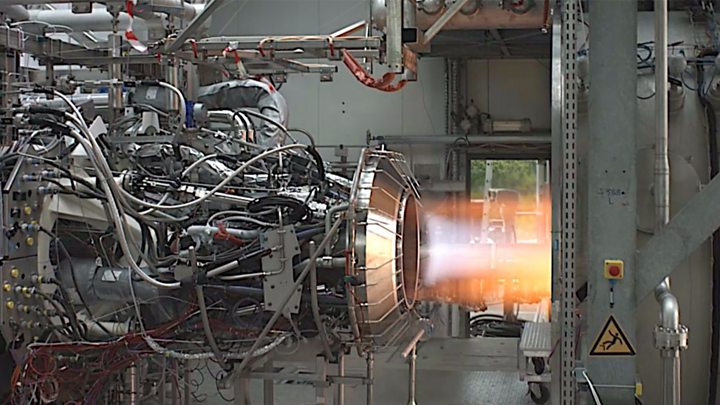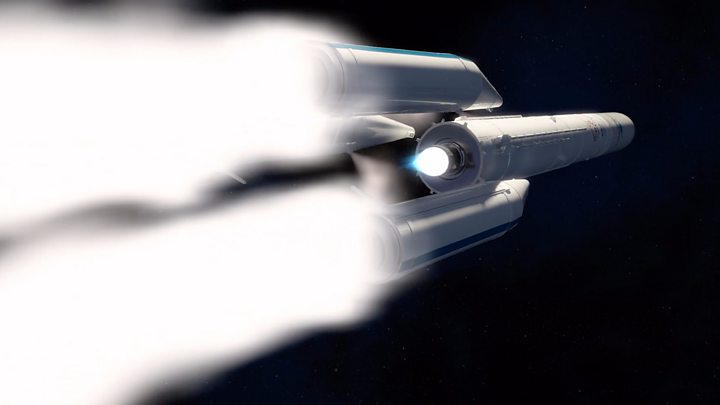10.11.2016
Full Ariane 6 rocket funding is unlocked by Esa
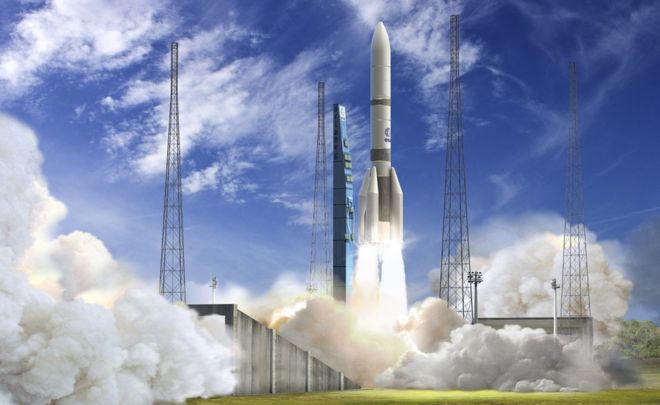 Image copyrightESA/DAVID DUCROS
Image copyrightESA/DAVID DUCROS
The final tranche of R&D funding needed to introduce a new rocket for Europe was committed on Wednesday.
The European Space Agency has amended an August 2015 contract with Airbus Safran Launchers (ASL), to unlock a further €1.7bn (£1.5bn; $1.9bn).
It tops up initial monies of €680m and means ASL can now complete development of the Ariane 6.
This new rocket will replace the Ariane 5 but, crucially, aims to cut current launch prices in half.
The move to a new vehicle is seen as vital if Europe is to maintain its competitive position.
The Ariane 5 is still the dominant player in the market for big commercial satellite launches, but this position is being challenged by a new wave of American offerings, in particular from the California SpaceX company.
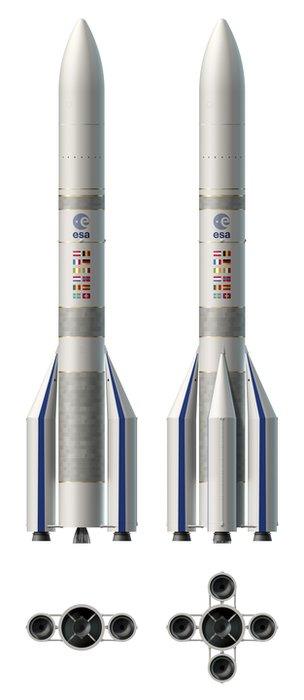
This US firm’s Falcon 9 rocket already undercuts the Ariane 5 on price and will get even cheaper if efforts to fly each vehicle multiple times prove successful.
The contract amendment signed in Paris follows approval by key committees at Esa in the past few days.
They signalled their contentment with the preliminary design progress on the Ariane 6 and the reorganisation in Europe’s rocket industry required to implement vehicle production.
The last detail to be agreed was the establishment of a second line of fabrication for the carbon-fibre casings of the 6’s strap-on, solid-fuel boosters.
This will be in Germany and will supplement the line already planned in Italy.
Many boosters are required, not only for the 6 but to use as the first stage on an upgrade to a smaller rocket known as Vega.
"Thanks to the trust and support of Esa and its member states' representatives, the industry has met its commitments and proved its ability to fulfil its role as a design and industrial authority," said Alain Charmeau, CEO of Airbus Safran Launchers.
“We have met the deadlines and quality objectives set, and now, thanks to the industrial organisation rolled out in record time, we can continue to develop a flexible, modular and competitive launcher that will fly in 2020".
The Ariane 6 will come in two versions. One, known as Ariane 62, will loft medium-sized spacecraft into orbit - the kind of platforms that image and study the Earth.
A second version, known as Ariane 64, will put up the heavy telecommunications spacecraft, which sit 36,000km above the equator.
The new rocket leans heavily on its heritage. Indeed, its upper-stage engine, called Vinci, was originally intended for an upgrade of the Ariane 5. Prototype Vinci test firings were conducted through the summer.
The Ariane 6 will fly from a dedicated launch pad at the Kourou spaceport in French Guiana. Jungle land has already been cleared for the facility, which is subject to separate contractual arrangements between Esa and the French space agency (CNES).
 Image copyrightASL
Image copyrightASL
Wednesday’s signing means there should be no arguments over the Ariane 6 when Europe’s research ministers meet for their big council gathering on 1/2 December in Lucerne, Switzerland.
In recent years, these fora have been dominated by negotiations over funding, national participation and workshare.
This time, the Council will confine itself to discussions about technology evolution programmes, such as the proposal to develop a liquid methane/oxygen engine dubbed Prometheus, which could one day power the Ariane 6’s core stage.
Engineers believe this propulsion unit would be substantially cheaper to produce than the Vulcain engine that will drive the 6 skyward when it starts operating in four years’ time.
Wednesday's contract amendments were signed at Esa HQ in Paris by the agency's director general, Jan Woerner, Mr Charmeau, and Jean-Yves Le Gall, the president of CNES. The signatures were inked in the presence of Thierry Mandon, French secretary of state for research and higher education.
 Image copyrightESA
Image copyrightESA
Quelle: BBC
-
Update: 23.01.2017
.
AIRBUS SAFRAN LAUNCHERS IN 2016: WE KEEP OUR PROMISES!
• A record year for Ariane 5
• Ariane 6 confirmed for a 1st flight in 2020
• The Group’s organization finalized, with the takeover of Arianespace
• 2017 will be a year of consolidation for Ariane 6 with continued development and the kick-off of production and marketing, while at the same time making 7 Ariane 5 flights.
2016 was a fundamental year for Airbus Safran Launchers: the construction of the company was finalized on 1st July, with integration of all its personnel, activities and sites in France and Germany. On 31st December last, Arianespace joined the Airbus Safran Launchers group, becoming a 74% owned subsidiary following the buy-out of the CNES shares. This finalizes the organization of the Group, which now comprises 11 subsidiaries, joint-ventures and major stake holdings.
This year was marked by a series of exceptional successes:
- With a total of 76 consecutive successful launches, achieved in December with the 7th launch of 2016, Ariane 5 broke Ariane 4’s record of 74 successful launches in a row. The launcher also broke a number of other records: performance, number of satellites placed in orbit and mission duration.
- The Ariane 6 program passed two decisive milestones: confirmation of launcher maturity following the first design review last June and signing of the amendment to the initial contract with ESA, enabling the necessary funds to be committed to finalizing development and industrial production.
At the same time, Airbus Safran Launchers is actively continuing to prepare for the European launchers of tomorrow, in particular with the Prometheus very low cost reusable engine project, which will make extensive use of 3D printing.
In the Defense field, all of the company’s goals were reached, in particular with the successful validation firing of an M51 strategic ballistic missile on July 1, 2016, from the “Le Triomphant” submarine. Through the development work it is conducting for the French defense procurement agency (DGA) Airbus Safran Launchers will continue to propose innovative and efficient solutions for the French Deterrent force.
“In 2016, Airbus Safran Launchers kept all its promises, placing Ariane 6 firmly on track, while continuing to ensure that Ariane 5 remains reliable and competitive. The finalization of the Airbus Safran Launchers group organization, including Arianespace, enables us to continue to set up a more integrated and optimized governance for the Ariane launchers, from design to marketing, while allowing Arianespace to continue to carry out its missions for its other customers in complete independence. I wish to thank the European Space Agency and the national agencies for their support, which has enabled us to achieve these excellent results”, said Alain Charmeau, CEO of Airbus Safran Launchers “However, this is just the beginning of the adventure and, in 2017, we will be kicking off the production of Ariane 6, to ensure that we are ready in 2020. Operation of Ariane 5 will continue, with seven launches scheduled for the year, while continuing to further improve launcher performance and cost reductions, on a market where competition is increasingly fierce. In this respect, the structuring of the European institutional market, through a multi-year order for 5 Ariane launchers, will be a key factor in competitiveness, both for our customers and for ourselves. Innovation must remain the driving force behind our creativity and our responsiveness, in order to facilitate access to space for our customers, both today and tomorrow”.
About Airbus Safran Launchers
Airbus Safran Launchers develops and supplies innovative and competitive solutions for civil and military space launchers. As lead contractor for the European Ariane 5 and Ariane 6 launcher families, as well as for the French oceanic deterrent force’s missiles, its expertise encompasses state-of-the art launch and propulsion system technologies. Airbus Safran Launchers is a joint venture equally owned by Airbus Defence and Space and Safran, which came about as a result of the desire by the two groups to take the European space industry to the highest possible level. With estimated sales of 2.5 billion euros, it employs more than 8,000 highly qualified staff on more than 13 main sites in France and Germany.
Quelle: Airbus Safran Launchers
---
Update: 1.04.2017
.
Airbus Safran Launchers and ONERA are cooperating more closely to prepare jointly the French and European space sector for the future
-
The Partnership Agreement applies to R&T activities in the field of launch systems for both civil and military use anticipated in the coming decades
-
This agreement underscores how the two players complement each other and defines the conditions for optimum collaboration in the future
-
A Steering Committee comprised of members of the two entities has been created and the first ten research topics have been defined
Airbus Safran Launchers and ONERA, the French national aerospace research center, have decided to cooperate more closely to prepare for the future.
The Partnership Agreement, created over the past few months by the two entities to define jointly the most efficient modes of collaboration, was signed in Paris by the CEO of Airbus Safran Launchers, Alain Charmeau, and Bruno Sainjon, the CEO of ONERA.
With the aim of meeting the looming global competitiveness and technological innovation challenges in the space and defense technology fields, this partnership will highlight the basic research developed by ONERA in fields related to strategic and space transport systems and technologies, as well as create more rigorous management of joint applied research carried out.
"This partnership agreement is looking to the long term and focuses on the technologies which will be implemented in the coming decades, in future civil and military space launcher programs, from solid to cryogenic propulsion, drawing on the most sophisticated digital technologies. It will enhance the complementarity between ourselves, an industrial concern faced with the market and the changing needs of our institutional and commercial customers, and ONERA, whose competencies are recognized worldwide, and will thus be able to assist us with optimal preparation for the future”, said Alain Charmeau, the CEO of Airbus Safran Launchers.
"The objectives and performance contract signed at the end of 2016 by the French Minister for Defense sets out the roadmap for ONERA for the period 2017-2021. It more specifically defines the expectations of the official agencies, primarily DGA, CNES and MESR, with respect to ONERA in terms of ballistic missiles and orbital systems. It also reaffirms the benefits to be had from strong ties between ONERA and industry. Airbus Safran Launchers - a major player in this field (as were the firms that it now comprises) - and ONERA have quite naturally been working together regularly for several decades. The agreement signed today aims to strengthen and organize this cooperation to build a long-term partnership. In the light of the strategic importance of the space sector, both military and civil, and the emergence of growing competition, this partnership agreement represents a boost for the future of French and European industry. This partnership is fundamental for research and for preparing for the future. It will enable us to keep pace with the best in the world”, added the CEO of ONERA, Bruno Sainjon.
In the coming months, the teams from Airbus Safran Launchers and ONERA will meet in working groups to address specific defined topics and will report on the progress of their work to a Steering Committee made up of members from the management of both parties.
The 10 research topics defined for the partnership:
-
Modeling of combustion in solid propulsion engines
-
Solid propulsion experimental resources
-
Hybrid propulsion
-
Oxygen-Methane propulsion
-
Instrumentation of test resources
-
CFD (Computational Fluid Dynamics) codes
-
Disruptive technologies for reusable launchers
-
Advanced Systems Engineering methods
-
Atmospheric re-entry of space debris
-
Electromagnetic radiation and lightning protection
About Airbus Safran Launchers
The Airbus Safran Launchers group develops and supplies innovative and competitive solutions for civil and military space launchers, with expertise in all aspects of state-of-the-art propulsion technologies. Airbus Safran Launchers is lead contractor for Europe’s Ariane 5 and Ariane 6 launcher families, responsible for both design and the entire production chain, up to and including marketing by its Arianespace subsidiary, as well as for the missiles of the French oceanic deterrent force. The Airbus Safran Launchers group and its subsidiaries enjoy a global reputation as specialists in the field of equipment and propulsion for space applications, while their expertise also benefits other industrial sectors. The group is a joint venture equally owned by Airbus and Safran, and employs nearly 9,000 highly qualified staff in France and Germany. Its estimated proforma revenues exceed 3 billion euros.
About ONERA
ONERA, a key player in aeronautics and space research, employs approximately 2000 people. Under the supervision of the Ministry of Defense, it has a budget of 230 million euros, of which more than half comes from commercial contracts. As a state expert, ONERA prepares tomorrow’s defense, meets future aerospace challenges, and contributes to the competitiveness of the aerospace industry. It is an expert in all of the disciplines and technologies of the field. All major civil and military aerospace programs in France and Europe have some of ONERA’s DNA: Ariane, Airbus, Falcon, Rafale, missiles, helicopters, engines, radars, etc. Recognized internationally and often receiving awards, its researchers train many doctoral students.
Quelle: ONERA
---
Update: 23.04.2017
.
AIRBUS SAFRAN LAUNCHERS INITIATES PRODUCTION OF THE ARIANE 6 GROUND QUALIFICATION MODELS
• The “Maturity Gate 6.1” industrialization review was held March 27 to April 20, 2017, among Airbus Safran Launchers, its industrial partners and independent experts
• Based on the positive outcome of this review, production of the Ariane 6 ground qualification models has been green-lighted
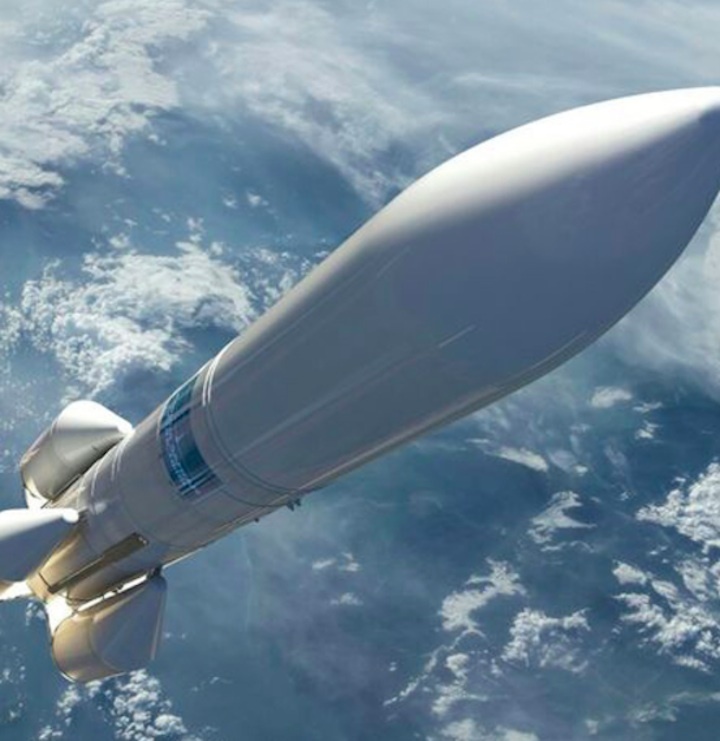
• The first flight of Ariane 6 is scheduled 2020
With “Maturity Gate 6.1”, Airbus Safran Launchers and its industrial partners have passed a major milestone in the development of Ariane 6, under contract with the European Space Agency (ESA). The review confirmed that the maturity of the industrialization of Ariane 6 is sufficient to begin production of the ground qualification models for the future European launcher, in accordance with the objectives of the program. This major step follows on from “Maturity Gate 5” which, in 2016, had enabled Airbus Safran Launchers to validate the technical, industrial and programming characteristics of Ariane 6 and to continue with development of the launcher with its partners, as planned.
“Beginning production of the Ariane 6 qualification elements is an important step forward, reflecting the originality and efficiency of the industrial process set up for its development, production and operation. In this way, we can meet our deadlines and respect our commitments”, stated Alain Charmeau, CEO of Airbus Safran Launchers. “The future European launcher is developed using validation milestones called “Maturity Gates”, as in the aeronautical industry, and we are going to start production of the first flight models by the end of the year, after reaching “Maturity Gate 6.2.”
The Ariane 6 development method, called “Ariane 6 Way”, comprises 15 major steps, 6 of which have already been completed. “Maturity Gate 11” will give the green light for the first flight of Ariane 6, while “Maturity Gate 15” will mark the end of development and the start of full operational capacity.
Each “Maturity Gate” takes place under the responsibility of Airbus Safran Launchers, and involves independent experts. “Maturity Gate 6.2” is slated to take place at the end of 2017, so that the production of the first Ariane 6 flight models can begin.
Ariane 6, which is also ideal for constellations, is built on behalf of the European Space Agency (ESA) and will be a flexible, modular and competitive launcher available in two versions, Ariane 62 and Ariane 64, to guarantee continued European access to space.
About Airbus Safran Launchers
The Airbus Safran Launchers group develops and supplies innovative and competitive solutions for civil and military space launchers, with expertise in all aspects of state-of-the-art propulsion technologies. Airbus Safran Launchers is lead contractor for Europe’s Ariane 5 and Ariane 6 launcher families, responsible for both design and the entire production chain, up to and including marketing by its Arianespace subsidiary, as well as for the missiles of the French oceanic deterrent force. The Airbus Safran Launchers group and its subsidiaries enjoy a global reputation as specialists in the field of equipment and propulsion for space applications, while their expertise also benefits other industrial sectors. The group is a joint venture equally owned by Airbus and Safran, and employs nearly 9,000 highly qualified staff in France and Germany. Its estimated proforma revenues exceed 3 billion euros.
Quelle: Airbus Safran
---
Update: 23.06.2017
.
Full thrust on Europe's new Ariane 6 rocket
Manufacturers say they are making rapid progress in the development of Europe's new rocket - the Ariane 6.
The vehicle is due to enter service in 2020, gradually replacing the existing workhorse, the Ariane 5.
The prime contractor, the recently rebranded ArianeGroup, gave an update on the status of the programme here at this week's Paris Air Show.
"We're on track with our roadmap and Ariane 6 is progressing very well," CEO Alain Charmeau told BBC News.
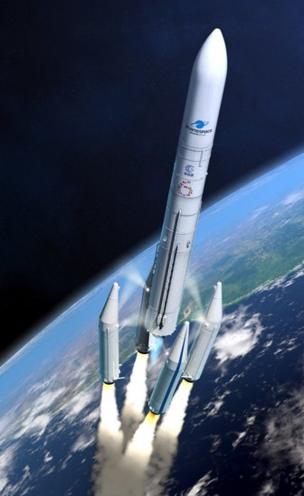
"Perhaps the most spectacular highlight at the moment is the testing of our Vinci engine. It's a brand new engine that will be on our new, versatile upper-stage. And on Monday we had another successful test. We're now well above 100 hundred tests."
The Vinci can be stopped and restarted multiple times. It will permit the Ariane 6 to conduct a broader range of missions than its predecessor.
It can also bring the upper-stage out of orbit after it has dropped off the satellite payload. This is a nod to the tightening "clean space" requirements that demand rocket operators leave as little debris in space as possible.
The recent Vinci firings are being conducted at a facility in Vernon, France. But even as these continue, production of the engine has started at a factory in Ottobrunn, Germany. This will be ramped up over the course of the next three years.
Ariane 6 is envisaged as something of a "jack of all trades" launcher. It will assume both the heavy-lifting duties of the Ariane 5 and the medium-lifting missions of the Russian Soyuz rocket that also operates out of Europe's spaceport in Kourou, French Guiana.
Ariane 6 will launch everything from constellations of small telecommunications satellites to giant, next-generation space telescopes. To achieve this, it will come in a couple of flavours - the A62 and the A64.
Each will have a liquid-fuelled (hydrogen and oxygen) Vinci upper-stage, and a liquid-fuelled core-stage that uses an improved version of the Ariane 5's current Vulcain engine.
But then two or four solid-fuelled boosters will be added, depending on how heavy the satellite payload is and where it needs to be placed in orbit, or even beyond Earth.
These boosters are being produced by the Italian Avio group and the first casing is due to head out to Kourou in the next few days to be filled with an inert fuel grain - to verify the overall design.
"It's an extremely light motor; very performing," said Avio's CEO Giulio Ranzo. "It's going to contribute significantly to the overall competitiveness of the launcher and the flexibility of turning it from a 62 to a 64."
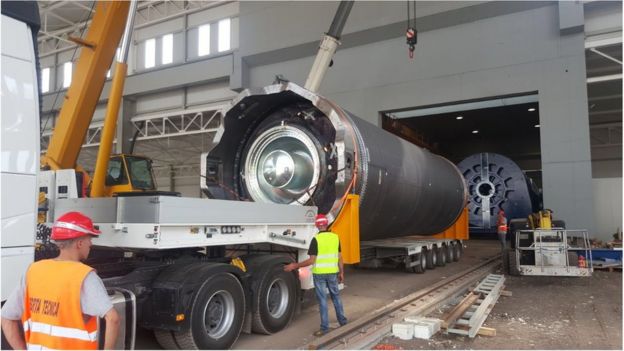 Image copyrightAVIO
Image copyrightAVIO
A new range of dispensers is also being developed for the Ariane 6. Dispensers are the devices that hold the satellite payload to the upper-stage during the ascent of the rocket, only letting it go when the right orbit is reached.
The expected menagerie of satellites will be mirrored by an equally diverse set of dispensers. Essential as well are new fairings - the clamshell-shaped covers that protect a satellite during the early flight phase up through the atmosphere.
Ariane 6 is getting two - one 14m high, the other 20m high.
These carbon fibre pieces are being made in one of the biggest curing ovens in the world by Swiss aerospace company RUAG Space.
"Our factory is up and running already," said chief executive Peter Guggenbach. "We've reduced the integration steps from five to one. The production is highly automated. Robots control every millimetre, ensuring we have zero defects."
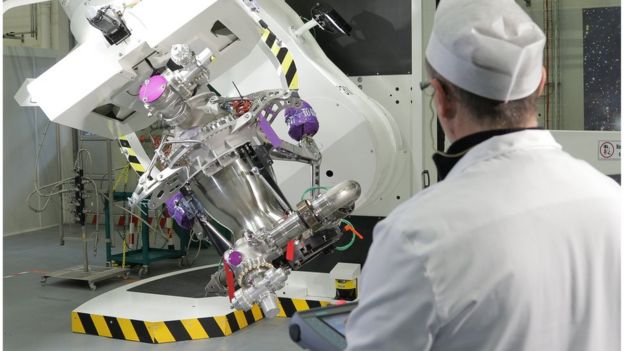 Image copyrightARIANEGROUP
Image copyrightARIANEGROUP
The manufacturing consortium is looking for a 40% cost reduction, at least, in the Ariane 6, compared with the Ariane 5. In part that is coming from exploiting new materials and new manufacturing techniques (3D printing, friction stir welding, augmented reality design, etc) and in part by maximising the common use of elements in both the 62 and 64 variants.
Avio's solid-fuelled booster is also the same as the first stage on the company's Vega rocket, which launches much smaller satellites.
But a big cost saving will come from simply employing fewer people.
"There is a transition from Ariane 5 to Ariane 6 (from 2020 to 2023), but from 2024, 2025 onwards - our workforce will be 30% less than today," explained Hans Steininger, the boss of MT Aerospace, which is making the rocket's huge metallic propellant tanks.
The Ariane 6 is on a tight schedule. The European Space Agency (Esa), whose member states are funding a large proportion of the development costs, has fixed 16 July 2020 as a deadline for the first flight.
"We are really at full speed," said Esa's director of launchers, Daniel Neuenschwander. "But we have to be to meet the target of July 2020. I signed an incentive scheme with industry, so they should be motivated," he told BBC News.
Quelle: BBC

